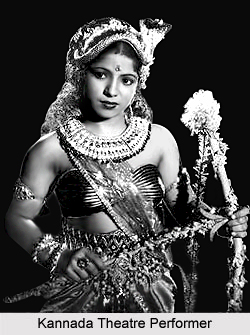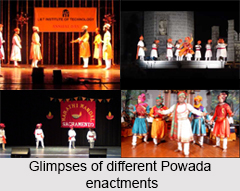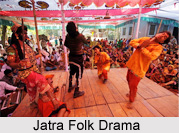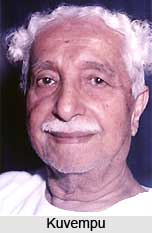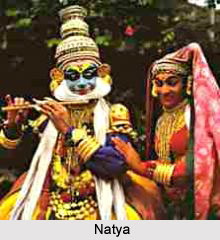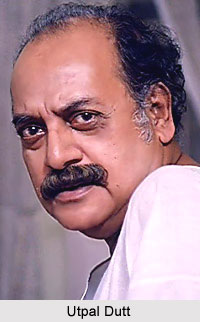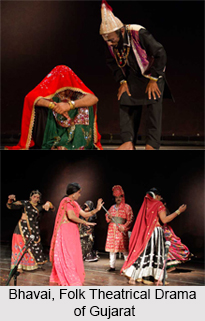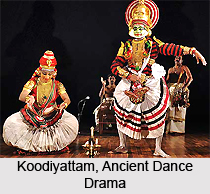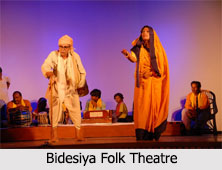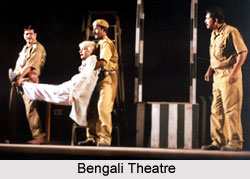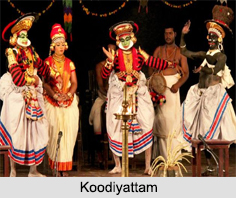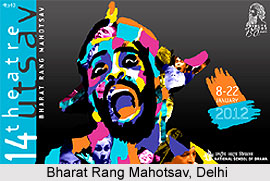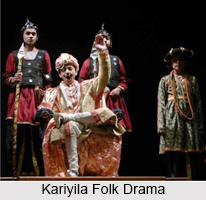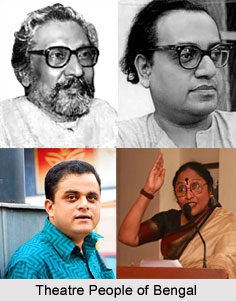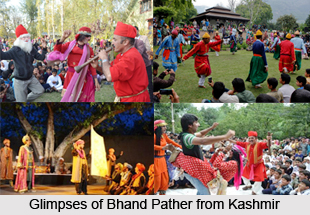 Bhand Pather is a traditional folk theatre form performed by the "bhand", i.e., folk entertainers of Kashmir, India. Bhands in India are now an endogamous Muslim community, which is no longer involved in their traditional occupation of folk entertainment. They include actors, dancers, minstrels, storytellers and impressionists. The payment for their performances is usually voluntary, often one performer going around the audience and collecting money on a "pay-what-you-can" basis while the others continuing to perform. While most Bhands belong to families that are engaged in folk entertainment as their hereditary profession, their specific art forms vary greatly by region, community and language. Bhand Pather is the dramatic form based on mythological stories, incorporating contemporary social satires within its practical theme. The theatre art form also essentially incorporates farcical elements, the storylines often enacted in a humorous and satirical manner.
Bhand Pather is a traditional folk theatre form performed by the "bhand", i.e., folk entertainers of Kashmir, India. Bhands in India are now an endogamous Muslim community, which is no longer involved in their traditional occupation of folk entertainment. They include actors, dancers, minstrels, storytellers and impressionists. The payment for their performances is usually voluntary, often one performer going around the audience and collecting money on a "pay-what-you-can" basis while the others continuing to perform. While most Bhands belong to families that are engaged in folk entertainment as their hereditary profession, their specific art forms vary greatly by region, community and language. Bhand Pather is the dramatic form based on mythological stories, incorporating contemporary social satires within its practical theme. The theatre art form also essentially incorporates farcical elements, the storylines often enacted in a humorous and satirical manner.
Etymology of Bhand Pather
The secular outlook of Bhands is reflected in their dynamic folk form that has incorporated many elements from the classical Sanskrit theatre as well as from other traditional folk forms of India. But over the years, many aspects have been lost and others have undergone dramatic changes.
The plays of the Bhands are called "Pather", a word that seems to have been derived from the term "patra", which means dramatic character. The term "Bhand" comes from "bhaana", that is a satirical and realistic drama, generally a monologue that is mentioned in Bharata`s Natya Shastra. The Bhand Pather, though, is not a monologue but a social drama incorporating mythological legends and contemporary social satire. Born Hindus, the Bhands converted to Islam and remain very secular in their outlook. They are an extremely simple, witty and practical people. The Bhand Pather unfortunately does not sustain them economically, thus they have been driven to other professions, which primarily encompass weaving the basket work of "kangris", woollen blankets and carpets.
History of Bhand Pather
Post tenth century, a number of foreign invasions took place in the Jammu & Kashmir valley and as a result, many disturbances had taken place in the social scenario for which the Kashmiri people had become slaves in their own motherland. They had to live and adapt with alien socio-political, religious and cultural systems. A reflection of this cross exchange can be found in the valley"s folk tradition. The anguishes of the people are evident in the plays, portrayed in a humorous or absurd form, such as the character of the king in Darza Pather or the royal soldiers in Shikargah, speaking in Persian language with the illiterate and poor Kashmiri, expecting him to understand and resorting to whipping if he failed in doing so, also in Angrez Pather where the English couple speaks a hilarious version of the language to a rest house guard while out on a hunt. Large puppets with masks are used to portray the sense of oppression, through the characters of the witch or the king in Gosain Pather, which is regarding Lord Shiva and the Shaivites of Kashmir. All these plays ultimately make the local character victorious in the end.
Form and Enactment of Bhand Pather
The Bhands dance to the tune of a specified "mukam" and the orchestra includes the Swarnai, Dhol, Nagara and Thalij. The Swarnai is larger in size than the Shehnai, with a strong and metallic sound that has an arresting impact in the open air arena. A very special wind instrument, it attracts audiences from the vicinity and is made in three parts: the "nai" or wooden pipe made by special carpenters, the "barg" which is a reed of a particular grass found locally and a copper disc, which is the diameter of the pipe into which the "barg" is fitted. Before the Swarnai player adopts his newly made instrument, a ritual offering is made in a "dargah". The composition played is called the "mukam", each Bhand Pather having its own. The music follows a set pattern: the Salaam, Thurau, Dubitch, Nau Patti and the Salgah. There is a highly developed system of music based upon the classical mould of the Sufiana Kalam, with intricate and codified patterns.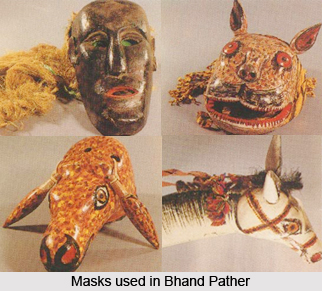
The man who plays the "dhol" is the central figure in the orchestra. Many "taals" in various combinations are played on this drum, but unfortunately today very few remain. The "nagara" is an accompaniment to the "dhol" and the rhythm doubles in intensity as the play proceeds. More than one "nagara" is used in the performance to emphasize the sound of the instrument. The "thalij" is a metal cymbal, a little larger than those used in other musical forms. To this music are added Kashmiri folk songs, sung throughout the play.
The two props that are a must for every Pather are a whip and a short bamboo stick. The long whip, known as the "koodar", is crafted from the dry stem of the Bhang plant and looks like a thick rope which is forked at its tip. When used, it emanates a sound similar to a gunshot. During the performance, a character can be whipped a hundred times without being hurt, because this prop does not have the impact associated with a whip, merely looking deadly. It is used to transform all the elements that represent oppression into strong dramatic images. In sharp contrast, the bans are used by the jester or "maskhara". These are split bamboo sticks that make a sharp sound. In his pantomime, the "maskhara" uses the bans, emerging as the total opposite of the oppressors" whip.
The "kaper chadar" or sheet of cloth is used as a curtain. Some of the actors make their entrance from behind this chadar. The same cloth is often used as a canopy for the king when he holds court is some other scenes. The use of the "kaper chadar" is reminiscent of the Yavanika described in the Natya Shastra, and which is also used in Kathakali and Yakshagana.
The predominant language in a Bhand Pather is Kashmiri, but there is also a use of Gujjari, Punjabi, Dogri, Persian and sometimes even English and other non-Kashmiri words, used to accentuate the humorous and absurd situations and create dramatic effects and incongruous expressions. The style of acting swings from the purely realistic to the highly exaggerated. The narrative of the Bhand Pather art form moves fairly rapidly from episode to episode, with no elements of suspense. It is epic in its quality with the audience knowing the action well. They know what is to come but do not know how the event will happen. Though the storyline revolves around old stories of kings and their times, the message projected is loaded with contemporary statements.
The Bhands are found in almost all the districts of Kashmir and performances are a regular feature of cultural life there. While some of the Pathers have passed away, others are becoming rare, but the form takes on new elements and continues to survive, alas precariously. The music has transformed and unfortunately the traditional "mukams" and "ragas" are not played as much. The Bhands in their day to day living reflect their firm belief, in the faith of a unique fusion of Kashmiri Shaivism and Sufi traditions of the valley.
Related Articles:
Folk Theatre in India
Kashmir
Performing Arts of Jammu & Kashmir
Sanskrit Theatre
Culture of Jammu and Kashmir
Jammu and Kashmir, Indian State
Tribes of Kashmir
Carpets of Kashmir
Origin of Kashmiri People
Shaivism in Kashmir
Folk Dances of Kashmir







